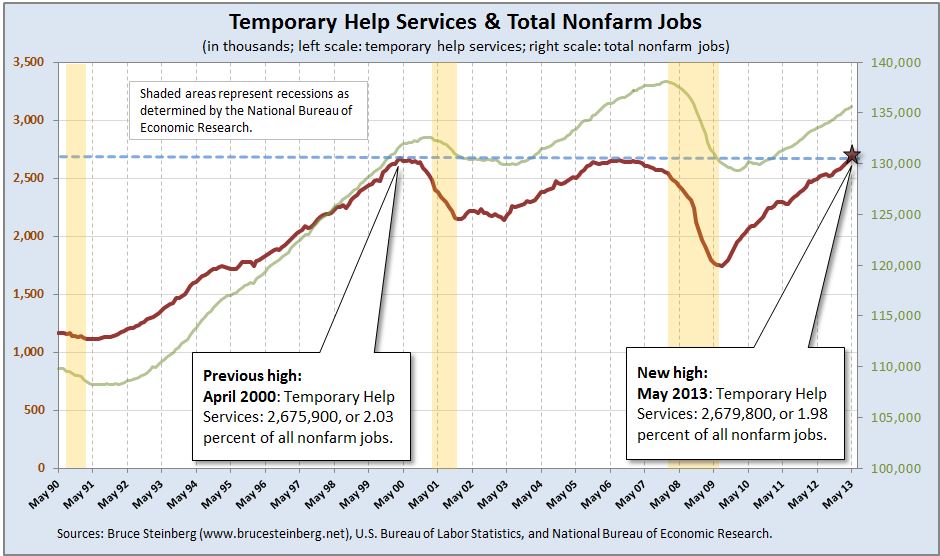
Source: Bruce Steinberg
Standard economist orthodoxy is that Non Farm Payroll is a “lagging indicator. What that means precisely is that the change in payroll in terms of both direction and magnitude will lag the overall business cycle. Meaning, the employment will turn up after he business cycle has already circled up, with the same pattern to the downside.
There is a caveat to this, in that hours worked, wages and temp help typically lead employment, and often is coincident or even leading to the business cycle.
Which brings us to the chart above, via Bruce Steinberg, who is the man when it comes to all things temp help. It shows Temporary Help Services surpassing prior highs set 13 years ago in April 2000.
Why is this significant? Very often, when companies engage in temp services for hiring, it can be a prelude to further permanent hiring. Some firms need immediate bodies faster than they can find ’em themselves; others are worried about future demand and are being (excessively) cautious. In each case, we often see the temp hiring lead more permanent hiring.
Here is Bruce:
Two sectors that were fairly important customers to many temporary help services back in 2000 were manufacturing and construction. In April 2000, those two sectors represented a total of 21.1 percent of all nonfarm employment. By 2006, they were only about 16 percent and last month those two sectors were only 13.1 percent of all nonfarm employment. And speaking of manufacturing — it could again become a major force for the staffing sector — there is speculation that the “energy revolution” could again make the United States a manufacturing powerhouse. For example, the cost of energy is about six times more expensive in Europe than in the U.S. so German carmaker BMW built a new factory in accordance to state-of-the-art sustainability principles in the U.S. to produce carbon fibers, which is a very energy intensive process. [We explored the apparent return of U.S. manufacturing in this space back in February.]
Temporary help services sector has been able to exceed its previous high 13 years ago despite significant shrinkage in two major customers sectors by servicing more sectors and / or broadening their array of services. But, they were not able to grow in terms of their share of the job market since the market share of temporary help services is slightly lower now (1.98 percent) than back in 2000 (2.03 percent).”
If you have any interest in the arcana of NFP, I suggest you sign up for Bruce’s free email — those of you who have a research budget can also buy The Liscio Report put out by Philippa Dunne. It is also outstanding.
Source
U.S. Employment Situation (May 2013)
Bruce Steinberg
BruceSteinberg.net | June 7, 2013
http://www.brucesteinberg.net/Newsletter_web_page.htm#Top


What's been said:
Discussions found on the web: